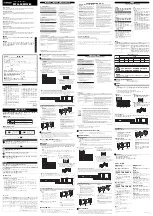
127
8.4 Procedure for Evaluation of the pH/ORP Electrode
The most common cause of a calibration failure is an electrode problem. First try cleaning the electrode, then retry
the calibration. If this fails again, replace the electrode and retry the calibration.
The next most common problem is wet or poor connections. Check the connection of the electrode to the cable for
moisture. Check the connections between the cable and the terminal strip. Make sure that they are tight, that the
terminal is not clamped to the plastic jacket, and that the wires are routed to the correct terminal. If there is a junction
box installed between the electrode and the controller, check the wiring there as well.
You should be able to measure the +5VDC ±5% and -5VDC ±5% vs IN- at the terminal strip. If not, the controller is
faulty. You should be able to measure the IN+ vs IN- (DC scale) and get the appropriate values for the buffer solu
-
tions used. If not, the preamplifier or its wiring is faulty.
The last possibility is to try replacing the preamplifier.
8.5 Diagnostic Lights
Some of the circuit boards inside the controller have diagnostic lights.
FRONT PANEL RED LED
Indicates an active alarm. Normal operation is that it is off unless the software reports an alarm condition, in which case it blinks
every second.
Possible Cause
Correction Action
Active alarm condition
Troubleshoot that particular alarm
FRONT PANEL GREEN LED
Indicates status of the software application. Normal operation is that 5 seconds after power-up, it is on. If it is not doing this:
Possible Cause
Correction Action
Controller software is not running
Try a power cycle to reset it
Faulty controller board
Replace controller board
CONTROLLER BOARD D1 LED
Indicates status of the software application. Normal operation is that 5 seconds after power-up, it does one long blink on, two short
blinks, on long blink off. If it is not doing this:
Possible Cause
Correction Action
Controller software is not running
Try a power cycle to reset it
Faulty controller board
Replace controller board
CONTROLLER BOARD
D10
LED
Indicates the status of the Ethernet software. Normal operation is that 5 seconds after power-up, it does 5 seconds on, 5 seconds off. If
it is not doing this:
Possible Cause
Correction Action
Ethernet software is not running
Try a power cycle to reset it
Faulty power supply
Replace power supply
CONTROLLER BOARD D3 LED
Indicates the status of the digital input software. Blinks slowly for a few seconds during power-up. Normal operation is OFF. If not
behaving this way:
Possible Cause
Correction Action
Digital input software locked up
Try a power cycle to reset it
Faulty controller board
Replace controller board
CONTROLLER BOARD D8 LED
Indicates the status of the 12VDC power supply. Normal operation is ON. If not on:
Possible Cause
Correction Action
Faulty ribbon cable
Replace ribbon cable
Faulty power supply
Replace power supply



































